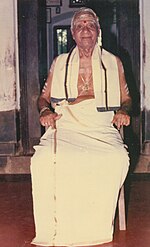In Indian aesthetics, a rasa (Sanskrit: रस) literally means "juice, essence or taste". It is a concept in Indian arts denoting the aesthetic flavour of...
27 KB (3,025 words) - 09:34, 17 August 2024
Rasa (Sanskrit: रास, IAST: rāsa) refers to the creation and reception of a distinct 'flavor' or quality of something. As a Sanskrit theological concept...
7 KB (861 words) - 00:05, 27 December 2023
Indian aesthetics (redirect from NavaRasa)
Pandanallur style expressions are more limited in scope. Rasa theory blossoms beginning with the Sanskrit text Nātyashāstra (nātya meaning "drama" and shāstra...
12 KB (1,469 words) - 10:34, 3 November 2024
emotion of emotionlessness) is considered as a ninth rasa, a concept of aesthetic flavour in Sanskrit literature. According to translation of Abhinavabhārati...
12 KB (1,460 words) - 03:20, 2 April 2024
Rasa (rásā रसा) is the name of a western tributary of the Indus in the Rigveda (verse 5.53.9). The word rasa means "moisture, humidity" in Vedic Sanskrit...
2 KB (257 words) - 03:07, 27 April 2024
Raslila (redirect from Rasa leela)
The Raslila (Sanskrit: रासलीला, romanized: Rāsalīlā), also rendered the Rasalila or the Ras dance, is part of a traditional story described in Hindu texts...
11 KB (1,257 words) - 16:01, 21 October 2024
Natya Shastra (category Articles containing Sanskrit-language text)
(in English and Sanskrit). Bhandarkar Oriental Research Institute. OCLC 11717230. Wallace Dace (1963). "The Concept of "Rasa" in Sanskrit Dramatic Theory"...
63 KB (7,130 words) - 11:02, 3 October 2024
Sanskrit literature is a broad term for all literature composed in Sanskrit. This includes texts composed in the earliest attested descendant of the Proto-Indo-Aryan...
102 KB (11,896 words) - 14:24, 2 November 2024
should be understood within the broader frame of Indian aesthetics as rasa (Sanskrit: रस), i.e. an emotion or feeling in the reader or audience that cannot...
13 KB (1,464 words) - 12:26, 3 May 2024
Sringara (category Articles containing Sanskrit-language text)
Sringara (Sanskrit: शृङ्गार, śṛṅgāra) is one of the nine rasas, usually translated as erotic love, romantic love, or as attraction or beauty. Rasa means "flavour"...
2 KB (216 words) - 21:35, 25 April 2024
Rambhadracharya (category Articles containing Sanskrit-language text)
in the Śṛngāra Rasa, Śrīsītārāmakelikaumudī is a work which has Vātsalya Rasa as the primary emotion, which is augmented by Śṛngāra Rasa. Dinkar notes...
126 KB (10,093 words) - 00:28, 17 October 2024
Rasasvada (category Sanskrit words and phrases)
defining literature. Rasa, originally propounded by Bharata and which is multifaceted, is the most important concept in Sanskrit criticism and has influenced...
7 KB (809 words) - 11:04, 4 August 2024
Ṛtusaṃhāra (category Sanskrit poetry)
ऋतुसंहार; ऋतु ṛtu, "season"; संहार saṃhāra, "compilation") is a medium length Sanskrit poem. While the poem is often attributed to Kalidasa, modern scholars disagree...
8 KB (939 words) - 12:26, 2 July 2024
Rasashastra (redirect from Rasa Shastra)
references to rasaśāstra. Where these texts use the word rasa, later commentators interpret rasa as mercury, despite the word having various other meanings...
9 KB (965 words) - 01:15, 28 September 2024
Hāsya (category Sanskrit words and phrases)
Hāsya (Sanskrit: हास्य) is a Sanskrit word for one of the nine rasas or bhava (mood) of Indian aesthetics, usually translated as humour or comedy. The...
3 KB (242 words) - 13:11, 3 October 2024
presented in a painting. Rasa is a Sanskrit word that denotes the quality of emotional fulfilment that a work of art brings about. Rasa Theory is a theory of...
11 KB (1,567 words) - 02:22, 26 January 2022
Sthayibhava (category Articles containing Sanskrit-language text)
transforms into Rasa. The concept of Sthayibhavas to produce Rasa was originally applied to drama but later on, it was used in most Sanskrit literature. Though...
5 KB (615 words) - 12:48, 8 August 2024
Sanskrit prosody or Chandas refers to one of the six Vedangas, or limbs of Vedic studies. It is the study of poetic metres and verse in Sanskrit. This...
48 KB (5,186 words) - 19:17, 24 October 2024
Bharata (sage) (category Sanskrit writers)
Mehta, T. (1995). Sanskrit Play Production in Ancient India. Motilal Banarsidass. Dace, W. (1963). "The Concept of "Rasa" in Sanskrit Dramatic Theory"...
3 KB (309 words) - 16:16, 8 October 2024
support the basic structure (and functioning) of the body. They consist of: Rasa dhatu (lymph) the substratum formed just after the digestion of food. The...
2 KB (204 words) - 13:30, 14 March 2024
Radha (category CS1 Sanskrit-language sources (sa))
introduced three forms of rasa dance—Maha rasa, Kunj rasa and Basant rasa. Later two more forms of rasa—Nitya rasa and Deba rasa was added by successive...
107 KB (11,599 words) - 23:43, 27 October 2024
The word "aamras" is derived from the Sanskrit words āmra (Sanskrit: आम्र; lit. 'mango') and rasa (Sanskrit: रस; lit. 'juice'), so the literal meaning...
4 KB (478 words) - 19:26, 10 August 2024
Dasharupakam (category 10th-century Sanskrit literature)
discusses, the subjects of Vastu(Plot), Netaa(the protagonist), and the Rasa (the emotive aspect) - which are essential to a play. The Dasharupakam comprises...
4 KB (441 words) - 10:14, 5 August 2024
dance Natyashastra Navarasa Nātyakalpadrumam Rasa (aesthetics) Sanskrit drama Tarla Mehta (1995). Sanskrit Play Production. Motilal Banarsidass.pp. 131–186...
6 KB (640 words) - 22:36, 19 June 2024
Mani Madhava Chakyar (category Indian Sanskrit scholars)
importance to both Rasa-abhinaya and Vachika-abhinaya.[citation needed] Chakyar was a Sanskrit scholar and gave lectures in Sanskrit. He studied Alankarashastra...
58 KB (5,473 words) - 06:13, 15 July 2024
Sheldon Pollock (category American Sanskrit scholars)
in Sanskrit before colonialism. He is also editing a series of Historical Sourcebooks in Classical Indian Thought, to which he has contributed A Rasa Reader:...
40 KB (4,613 words) - 14:44, 2 November 2024
Kumarabhargaviyacampu Rasamānjari (Bouquet of Rasa) Rasatarangini (Rivers of Rasa) Pollock, Sheldon (2009). "Bouquet of Rasa" & "River of Rasa". NYU Press. pp. xx–xxi. ISBN 9780814767559...
4 KB (394 words) - 09:10, 17 August 2024
Shringara-Prakasha (category Articles containing Sanskrit-language text)
voluminous set of Sanskrit poetry consisting of thirty-six chapters, documented in 1908. It deals mostly with Alamkara-Shastra (rhetoric) and rasa, and is claimed...
6 KB (794 words) - 06:13, 16 April 2024
Sangita Ratnakara (category 13th-century Sanskrit literature)
musicological texts from India. Composed by Śārṅgadeva (शार्ङ्गदेव) in Sanskrit during the 13th century, both Carnatic music and Hindustani music traditions...
20 KB (2,070 words) - 13:57, 3 April 2024
The Clay Sanskrit Library is a series of books published by New York University Press and the JJC Foundation. Each work features the text in its original...
18 KB (2,034 words) - 21:00, 10 September 2024













